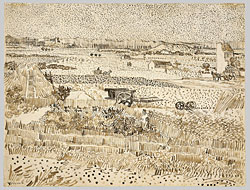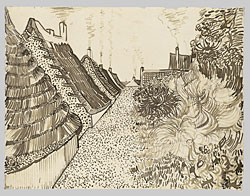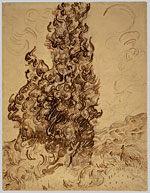
“And the big news from artblog is, Van Gogh is good,” said Steve, making fun of us because we really really liked the Van Gogh show at the Metropolitan Museum of Art (yup, we made it to New York, finally) (left, “Harvest in Provence,” 1888).
OK, so the excellence of Van Gogh is no surprise.
But the show makes a timely pairing with Martin Scorsese’s amazing Bob Dylan movie that aired a few weeks ago on public television. The exhibit and the movie show two remarkable journeys. Each man seems not especially talented to those around him when he starts out, Dylan seemingly an ordinary musician and Van Gogh an ordinary guy who doesn’t even know the fundamentals of drawing and doesn’t have finesse of touch.
 Both of them were autodidacts who plunged themselves full force into the material they wanted to master, looking, copying, listening, doing whatever it took to absorb everything around them (right, “Street in Saintes-Maries-de-la-Mer,” 1888).
Both of them were autodidacts who plunged themselves full force into the material they wanted to master, looking, copying, listening, doing whatever it took to absorb everything around them (right, “Street in Saintes-Maries-de-la-Mer,” 1888).
And both of them began producing in a short period of time enormous amounts of work that ultimately went in directions no one could have predicted.
 The Van Gogh show lays bare the development of his genius. To me, this is the crux of the story told in 113 works, mostly drawings, which lay bare the mental and mechanical progress from nice landscapes about the vitality of nature to roiling landscapes about the vitality of nature. Van Gogh develops strategies to compensate for his drawing “fist”–short multiple lines to define a large volume and space–and eventually ends up with a varied, inspired variety of turbulent markmaking that brings new ways of drawing to a craft that’s been around as along as people (left, “Cafe Terrace on the Place du Forum,” 1888).
The Van Gogh show lays bare the development of his genius. To me, this is the crux of the story told in 113 works, mostly drawings, which lay bare the mental and mechanical progress from nice landscapes about the vitality of nature to roiling landscapes about the vitality of nature. Van Gogh develops strategies to compensate for his drawing “fist”–short multiple lines to define a large volume and space–and eventually ends up with a varied, inspired variety of turbulent markmaking that brings new ways of drawing to a craft that’s been around as along as people (left, “Cafe Terrace on the Place du Forum,” 1888).You also see him drawing figures, starting with nice drawings, and ending with iconic shapes that speak to the amazing portraits of Mme. and M. Gachet. You also see some paintings that seem less than amazing and ultimately, the paintings with swirling brush strokes that make him famous.
 But the drawings are not just steps to paintings; they are amazing works of art in and of themselves. In the course of his brief career, Van Gogh made more than 1,000 drawings (right, “Cottage Garden,” 1888).
But the drawings are not just steps to paintings; they are amazing works of art in and of themselves. In the course of his brief career, Van Gogh made more than 1,000 drawings (right, “Cottage Garden,” 1888).The work he created was impossible to predict. It poured out of him in just 10 years; the height of his powers lasted only two years. In that brief time, he pushed the edges of the crafts of painting and drawing. Dylan’s most productive period of ground-breaking music follows a similar trajectory.
 My one regret is that I didn’t see the Jacob van Ruisdael landscapes at the PMA first. Van Ruisdael’s metaphoric approach to landscape and its spiritual nature is father to Van Gogh’s, and some of the use of space is similar. But Van Gogh’s nature is about vitality, van Ruisdael’s more about mortality (left, “Cypresses,” 1889).
My one regret is that I didn’t see the Jacob van Ruisdael landscapes at the PMA first. Van Ruisdael’s metaphoric approach to landscape and its spiritual nature is father to Van Gogh’s, and some of the use of space is similar. But Van Gogh’s nature is about vitality, van Ruisdael’s more about mortality (left, “Cypresses,” 1889).
Time and genius are not all that kind to either Van Gogh or Dylan. In the end, Van Gogh breaks down and ultimately commits suicide. And Dylan turns into one strange dude. The problem they both faced–Where’s a genius to go next?









